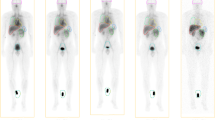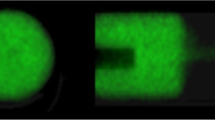Abstract.
The purpose of this study was to determine the biodistribution and the associated radiation dose of technetium-99m 4,5-bis(thioacetamido)pentanoyl-annexin-V (99mTc-Apomate), a tracer proposed for the study of apoptosis. Eight patients (including two females) with normal kidney and liver functions were included in the study. An activity of 580±90 MBq of 99mTc-Apomate was injected intravenously, immediately followed by a dynamic study of 30 frames of 1 min each. At about 1 h, 4 h and 20 h p.i., whole-body scans were acquired. All activity distributions were measured using a dual-head gamma camera. Before injection of activity, a transmission scan with a cobalt-57 flood source had been performed to determine patient attenuation. Blood samples were taken every 10 min during the first hour after injection, and at about 4 and 20 h. Urine and faeces were collected during the first 20 h. Organ uptake was estimated after correction for body background activity, attenuation and scatter. Residence times were calculated from the dynamic and whole-body studies and used as input in the Mirdose 3.1 program to obtain organ doses and effective dose. It was found that radioactivity strongly accumulated in the kidneys and the liver [at 70 min p.i., 28%±8% and 20%±4% of the injected dose (ID), respectively]. Uptake in the target tissues (lymphomas or heart) was negligible from a dosimetric point of view. Extrapolating data from the first 20 h, one finds that approximately 73% of the ID will be excreted in the urine, and 27% in the faeces. The biological half-life of the activity in the total body was 16±7 h. Some organ doses ± standard deviation (SD) in µGy/MBq were: kidneys 63±22, urinary bladder 20±6, spleen 15±3, liver 13±3, upper large intestine 12±6, lower large intestine 8±4, testes 6±2 and red bone marrow 4±0.7. The effective dose was 7.6±0.5 µSv/MBq, corresponding to a total effective dose of 4.6±0.3 mSv for a nominal injected activity of 600 MBq. In conclusion, 99mTc-Apomate has a high uptake in the kidneys and liver – in fact a factor of 1.3–1.6 higher than that found for the previously studied 99mTc-(n-1-imino-4-mercaptobutyl)-annexin-V. The biological half-life is shorter, however, but still long compared with the physical half-life of 99mTc. The faster appearance of activity in the intestines may preclude imaging of apoptosis in the abdomen. The effective dose is within the lower range of values reported for typical 99mTc compounds.
Similar content being viewed by others
Author information
Authors and Affiliations
Additional information
Received 17 March and in revised form 10 May 2001
Electronic Publication
Rights and permissions
About this article
Cite this article
Kemerink, G.J., Boersma, H.H., Thimister, P.W. et al. Biodistribution and dosimetry of 99mTc-BTAP-annexin-V in humans. Eur J Nucl Med 28, 1373–1378 (2001). https://doi.org/10.1007/s002590100578
Published:
Issue Date:
DOI: https://doi.org/10.1007/s002590100578




